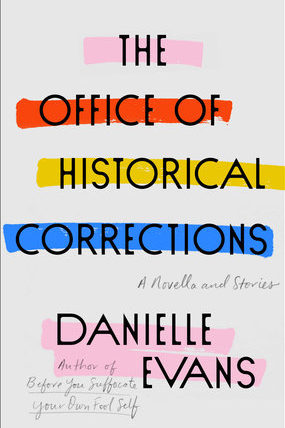The Office of Historical Corrections
by Danielle Evans
reviewed by Caroline Tew
Just as there is an art to the short story, there is also an art to the short story collection. The writer must strike a delicate balance by maintaining thematic cohesion without indulging in repetition. Too often collections go awry: the stories have nothing in common except the author, an overarching theme generates a one-note collection, or the quality of the content varies wildly. In The Office of Historical Corrections, her second collection, Danielle Evans walks this tightrope with ease: each story contributes to a nuanced exploration of race and racism in America, offering a series of “what-ifs” and seeing them through to the end.
The most compelling piece is the titular novella, which follows Cassie, a worker at the Department of Political Correctness. Her job is to correct historical inaccuracies in anything from fliers to government documents. When an ex-employee, Genie, goes rogue and changes a plaque in small-town Wisconsin to name the white killers responsible for setting fire to a Black man’s house, Cassie has to pick up the pieces and evade violence from a particularly upset and violent white supremacist.
Evans reveals the complexities in rooting out racism. Here, she wants us to understand that while there is a kind of justice in naming those responsible for lynchings and other anti-Black hate crimes, if we insist on naming every violent racist, “the sometimes brutality and sometimes banality of antiblackness” becomes “the loop of history that was always a noose if you looked at it long enough.” Although naming the perpetrators seems only right, Cassie also recognizes that there is something demoralizing about living with the constant reminder that, in her country, Black people have been consistently persecuted.
Other stories in the collection grapple with similarly difficult issues. “Boys Go to Jupiter” tackles the topic of white fragility. When Claire offhandedly posts a selfie wearing a Confederate flag bikini—a bathing suit she admits is ugly, yet wears to please her boyfriend and annoy her stepmother—she’s shocked to find that a Black girl in her dorm is offended enough to post about it in protest. In her annoyance, Claire slips a note under the girl’s door using a postcard printed with the Confederate flag, a gesture which subsequently lands her in a disciplinary hearing for threatening a student. “A threat of what?” she asks. “That I was going to legally enslave her? Secede from the hallway, declare war on her, and then lose?” What Claire takes as an innocuous joke belies the truth of micro (and not-so-micro) aggressions: that it’s difficult for people who believe themselves not to be racist to see the problem with their actions.
Evans portrays Claire not as an evil white woman but as a sad, lonely young adult too stubborn to back down after making a mistake. She’s not particularly fond of the flag, but feels compelled to stand her ground, unwilling to see herself as racist. But here again Evans declines to see only one side of the issue. Instead, she pulls at the loose threads, and rather than the didactic diatribe this collection could have been, each story is a study in subtlety.
Every collection has its weak point, but in The Office of Historical Corrections, only one story falls flat. In “Anything Can Disappear,” Vera is left with a toddler on the bus but fears taking him to the police because she’s carrying a large quantity of drugs. Instead of returning the boy after the drop off, Vera decides to raise him as her own because it doesn’t appear that his mother is searching for him. The murky morality of this story—whether or not Vera is doing the ethical thing by caring for this abandoned child—is overshadowed by the unrealistic nature of the situation. The ending, in which Vera leaves a note with the unsupervised child in the home of his biological father, is also vaguely unrealistic and unsatisfying.
As a collection, The Office of Historical Corrections achieves a level of sophistication that most writers can only hope for. The stories ask difficult questions about racism, attempting to unravel the intricacies but ultimately leaving the reader with a knot they must untangle themselves.
Published on June 25, 2021

